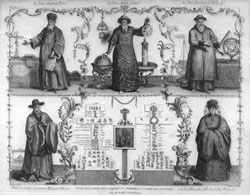
2. Mathematics and Mission
Matteo Ricci was the first Jesuit to establish himself successfully at the Chinese court in Beijing, and clearly saw the potential of mathematics to engage his audience of Chinese literati. He not only published translations of European mathematical books with the assistance of Chinese scholars but, from the very beginning of his mission, recognised the power of objects both for spectacular display and as persuasive gifts. He made and distributed instruments and clocks and saw mapmaking as being "not at all out of keeping with his ideas of preaching the Gospel. According to the disposition of Divine Providence, various ways have been employed at different times, and with different races, to interest people in Christianity. In fact this very attraction was to draw many of the Chinese into the net of Peter." (Nicolas Trigault, De Christiana expeditione apud Sinas, 1615)

The image comes from a major 18th-century European work on China by the French Jesuit Jean-Baptiste Du Halde, the Description geographique, historique, chronologique, politique, et physique de l'empire de la Chine (Paris, 1735). The lower section depicts two prominent early Chinese converts to Christianity - a mandarin and his granddaughter - as evidence of the success of the Jesuit mission.
The upper portion personifies and celebrates the mission through three of the leading Jesuit figures of its first century. Ferdinand Verbiest is the third in line and his instruments show that he continued the strongly mathematical emphasis which had been inaugurated by his two predecessors, Matteo Ricci (left) and Johann Adam Schall von Bell (centre).